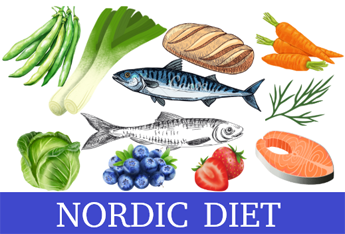The Nordic Diet: Healthy Eating with an Eco-Friendly Approach
The Nordic diet is gaining global attention as a sustainable and healthy eating plan that combines traditional Nordic foods with modern nutrition science. Originating in Denmark, Finland, Iceland, Norway, and Sweden, this diet promotes eating locally sourced, seasonal foods while supporting the environment

What Makes the Nordic Diet Unique
The Nordic diet staples include:
-
✅ Whole grains like rye, barley, and oats
-
✅ Fresh berries and other seasonal fruits
-
✅ A variety of vegetables, especially cabbage and root vegetables such as potatoes and carrots
This eating pattern is praised by nutrition experts for its focus on high-quality, unprocessed foods and balanced nutrition. According to Dr. Frank Hu, professor of nutrition at the Harvard T.H. Chan School of Public Health, the Nordic diet shares many similarities with the Mediterranean diet, which is widely regarded as one of the best diets for heart health and disease prevention.
Key Health Benefits of the Nordic Diet
-
✅ Promotes heart health
-
✅ Supports healthy weight management
-
✅ Improves blood pressure and cholesterol
-
✅ Reduces inflammation with omega-3 fatty acids and antioxidants
-
✅ Encourages eco-friendly, sustainable eating habits
Nordic Diet vs. Mediterranean Diet
While both diets emphasize on :
-
✅ eating fatty fish 2 to 3 times a week, ensuring a good intake of heart-protective omega-3s.
-
✅ limit red meat, sweets, and highly processed foods, making them equally beneficial for long-term health.
Key differences include:
-
✅ The Mediterranean diet uses olive oil, while the Nordic diet prefers rapeseed oil (canola oil), which is rich in monounsaturated fats and alpha-linolenic acid (ALA), a plant-based omega-3 fatty acid.
-
✅ One of the core strengths of the Nordic diet is its emphasis on high-quality carbohydrates from whole grains. Popular options include cereals and breads made with barley, oats, and rye. Examples – Swedish Wasa crispbreads, and
(a dense sourdough rye bread, a favorite in Denmark). These whole-grain foods are loaded with fiber, vitamins, minerals, and antioxidants, promoting heart health and better digestion. -
✅ Another unique highlight of the Nordic diet is its focus on berries. From blueberries and lingonberries to blackberries, these fruits are nutritional powerhouses. Research from Harvard scientists links regular berry consumption to lower weight gain and a reduced risk of heart attacks. Rich in anthocyanins, these plant compounds help lower blood pressure and improve blood vessel flexibility, supporting overall cardiovascular health.
Read further on:
≺≺ What cardiovascular benefits do berries provide?
≺≺ What Is the Ketogenic Diet? Is the Keto Diet Right for Everyone?
≺≺ What is the Okinawan diet? What is the secret behind Okinawan long life expectancy?
≺≺ Ultra-Processed Foods: What They Are, Why They’re Harmful, and How to Cut Back.
≺≺ What eating strategies work best for losing weight long term?
≺≺ How Do Sugary Meals and Beverages Harm Dental Health?
≺≺ Why Vitamin B12 Is Important for Your Health?
≺≺ What type of exercise is best for lowering my blood sugar?
≺≺ What foods should people with high blood pressure avoid?
≺≺ What foods and vitamins are good for your skin?
≺≺ What are the top three minerals you can take to boost memory?
≺≺ Why is regular table salt considered unhealthy?
≺≺ What makes Himalayan salt different from regular table salt?
≺≺ What is wrong with ONE-A-DAY Vitamins?
≺≺ What health problems are linked to consuming corn syrup?
≺≺ What food is most effective for moderating blood sugar?
≺≺ EWG’s- The Clean Fifteen: Fruits and Vegetables with the Lowest Pesticide Levels.
≺≺ What are antioxidants? How antioxidants in the fruits and vegetables help in preventing cancers and diseases?
≺≺ How can I reduce the risk of cancer-causing chemicals when cooking or grilling meat?
≺≺ What happens to my blood vessels when I gain weight?
≻≻ Watch this page for more such informative articles on Health, Nutrition, and Wellness.
≻≻-Back to Home page.
Further reading (External Links opens in new window):
≺≺- National Library of Medicine – The Mediterranean and Nordic Diet: A Review of Differences and Similarities of Two Sustainable, Health-Promoting Dietary Patterns.
≺≺- Harvard Health Publishing – The Nordic diet: Healthy eating with an eco-friendly bent.

